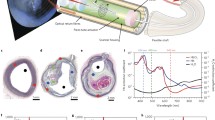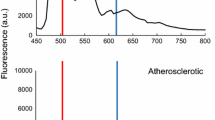Abstract
We have investigated laser-induced fluorescence frompost mortem human arteries in order to find spectroscopic properties allowing discrimination between normal and atherosclerotic vessel wall. A pulsed nitrogen laser emitting light at a wavelength of 337.1 nm was used as an excitation source. The fluorescence spectrum from 370 to 700 nm was captured and analysed by an optical multichannel analyser. Dimensionless contrast functions were formed by using characteristic spectral features at 390, 415, 480, 580 and 600 nm. All samples were investigated in scans across a region where normal as well as diseased vessel wall appeared. The types of plaque were histopathologically divided into four groups, of which three could be singled out using one or more of our spectroscopic criteria. We also investigated the different layers of the normal and diseased vessel wall in order to determine the various contributions to the fluorescence signal. Furthermore, plasma emission spectra were recorded while ablating the normal as well as the diseased vessel wall with an excimer laser, emitting radiation at 308 nm, thus detecting the change in spectral characteristics during the ablation process down into deeper layers.
Similar content being viewed by others

References
Isner JM, Clarke RH. The current status of laser in treatment of cardiovascular disease.IEEE J Quant Electr 1984,QE-20:1406–20
Geschwind H, Boussignac G, Teisseire B et al. Percutaneous transluminal angioplasty in man.Lancet 1984,i:844
Choy DSJ. Vascular recanalization with laser catheter.IEEE J Quant Electr 1984,QE-20:1420–6
Choy DSJ, Stertzer SH, Myler RK et al. Human coronary laser recanalization.Clin Cardiol 1984,7:377–81
Isner JM, Steg PG, Clarke RH. Current status of cardiovascular laser therapy, 1987.IEEE J Quant Electr 1987,QE-23:1756–71
Lammer J, Pilger E. Laser angioplasty by contact probes: experimental and clinical investigations.Lasers in Med Sci 1988, (Suppl.) July:328
Belli A-M, Cumberland DC. Percutaneous laser assisted angioplasty: initial results using the spectraprobe in peripheral arterial occlusions.Lasers in Med Sci 1988, (Suppl.) July:329
Grundfest WS, Litvack F, Forrester JS et al. Laser ablation of human atherosclerotic plaque without adjacent tissue injury.J Amer Coll Cardiol 1985,5:929–33
Isner JM, Donaldson RF, Deckelbaum LI. The excimer laser: Gross, light microscopic and ultrastructural analysis of potential advantages for use in laser therapy of cardiovascular disease.J Amer Coll Cardiol 1985,6:1102–9
Deckelbaum LI, Isner JM, Donaldson RF. Use of pulsed energy delivery to minimize tissue injury resulting from carbon dioxide laser irradiation of cardiovascular disease.J Amer Coll Cardiol 1986,7:898–908
Wollenek G, Laufer G, Pinterits F et al. Excimer laser angioplasty: initial clinical results in total peripheral occlusion.Lasers in Med Sci 1988, (Suppl.) July:330
Erikson U, Helmius G, Hemmingsson A et al. Repeat femoral arteriography in hyperlipidemic patients.Acta radiologica 1988,29:303–9
Alfano RR, Darayash BT, Cordero J et al. Laser induced fluorescence spectroscopy from native cancerous and normal tissue.IEEE J Quant Electr 1984,20:1507–11
Yanming Ye, Yuanlong Yang, Yufen Li, Fuming Li. Characteristic autofluorescence for cancer diagnosis and the exploration of its origin.Technical Digest, Conference on Lasers and Electro-Optics (CLEO), Baltimore, MA, USA 1985:84
Kato H, Cortese DA. Early detection of lung cancer by means of hematoporfyrin derivative fluorescence and laser radiation.Clin Chest Med 1985,6:237–53
Profio AE, Doiron DR, Sarnaik J. Fluorometer for endoscopic diagnosis of tumors.Med Phys 1984,11:516–20
Kittrell C, Willett RL, le los Santos-Pacheo C et al. Diagnosis of fibrous arterial atherosclerosis using fluorescence.Appl Opt 1985,24:2280–1
Cothren RM, Hayes GB, Kramer JR et al. A multifiber catheter with an optical shield for laser angioplasty.Lasers in the Life Sci 1986,1:1–12
Sartori M, Sauerbrey R, Kubodera S. Autofluorescence maps of atherosclerotic human arteries—a new technique in medical imaging.IEEE J Quant Electr 1987,23:1794–7
Oraevsky AA, Letokhov VS, Omelyanenko VG et al. Laser spectral analysis of human atherosclerotic vessels. In: Persson W, Svanberg S (eds)Laser Spectroscopy VIII, Springer Series in Optical Sciences. Berlin: Springer 1987:370–1
Andersson PS, Gustafson A, Stenram U et al. Diagnosis of arterial atherosclerosis using laser-induced fluorescence.Lasers in Med Sci 1987,2:261–6
Deckelbaum LI, Sarembock IJ, Stetz ML et al.In-vivo fluorescence spectroscopy of normal and atherosclerotic arteries.Proceedings of the Conference on Optical Fibers in Medicine III. Los Angeles, CA, USA: SPIE-The International Society for Optical Engineering 1988:314
Blankenhorn DH, Freiman DG, Knowles HC. Carotenoids in man. The distribution of epiphasic carotenoids in atherosclerotic lesions.J Clin Invest 1958,35:1243–7
Blankenhorn DH, Braunstein H. Carotenoids in man III. The microscopic pattern of fluorescence in atheromas and its relation to their growth.J Clin Invest 1958,37:160–5
Blankenhorn DH. The infiltration of carotenoids into human atheromas and xanthomas.Ann Intern Med 1960,35:944–54
Prince MR, Deutsch TF, Mathews-Roth MM et al. Preferential light absorption in atheromas in vitro.J Clin Invest 1986,78:295–302
Prince MR, LaMuraglia GM, MacNicol EF Jr. Increased preferential absorption in human atherosclerotic plaque with oral beta carotene: implications for laser endarterectomy.Lasers in Med Sci 1988, (Suppl.) July:184
Spokojny AM, Serur JR, Skillman J, Spears JR. Uptake of hematoporphyrinderivative by atheromatous plaques: studies in human in vitro and rabbit in vivo.J Amer Coll of Cardiol (JACC) 1986,8:1387–92
Kessel D, Sykes E. Porphyrin accumulation by atheromatous plaques of the aorta.Photochem Photobiol 1984,40:59–61
Montán S, Svanberg K, Svanberg S. Multicolor imaging and contrast enhancement in cancer-tumor localization using laser-induced fluorescence in hematoporphyrinderivative-bearing tissue.Opt Lett 1985,10:56–8
Andersson PS, Montán S, Svanberg S. Multispectral system for medical fluorescence imaging.IEEE J Quant Electr 1987,23:1798–1805
Hohla K, Laufer G, Wollenek G et al. Simultaneous tissue identification and ablation with excimer laser.Proceedings of The International Society for Optical Engineering. Los Angeles, CA, USA: (SPIE) 1988,908:129–36
Richards-Kortum RR, Mehta A, Kolubayev T et al. Spectroscopic diagnosis for control of laser treatment of atherosclerosis. In: Persson W, Svanberg S (eds)Laser Spectroscopy VIII, Springer Series in Optical Sciences. Berlin: Springer 1987:366–9
Svanberg K, Kjellén E, Ankerst J et al. Fluorescence studies of hematoporphyrin derivative in normal and malignant rat tissue.Cancer Research 1986,46:3803–8
Andersson-Engels S, Johansson J, Svanberg S et al., to appear.
Boulnois J-L. Photophysical processes in recent medical laser developments: a review.Lasers in Med Sci 1986,1:47–66
Boulnois J-L. Photophysical processes in laser-tissue interactions. In: Ginzburg R (ed)Laser Applications in Cardiovascular Diseases. New York: Futura 1987
Kirschenbaum DM.Atlas of protein spectra in the ultraviolet and visible regions. New York: IFI/Plenum Data Corporation 1974:266
Richards-Kortum RR, Mehta A, Kolubayev T et al. Role of collection geometry in spectral diagnosis of atherosclerosis.Proceedings at CLEO'88. Anaheim, CA, USA, 1988:366–7
Andersson-Engels S, Ankerst J, Montan S et al. Aspects of tumour demarcation in rats by means of laser induced fluorescence and haematoporphyrin derivatives.Lasers in Med Sci 1988,3:239–48
Measures RM.Lasers Remote Sensing: Fundamentals and Applications. New York: Wiley 1984
Author information
Authors and Affiliations
Rights and permissions
About this article
Cite this article
Andersson-Engels, S., Gustafson, A., Johansson, J. et al. Laser-induced fluorescence used in localizing atherosclerotic lesions. Laser Med Sci 4, 171–181 (1989). https://doi.org/10.1007/BF02032432
Received:
Issue Date:
DOI: https://doi.org/10.1007/BF02032432



